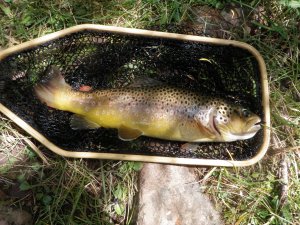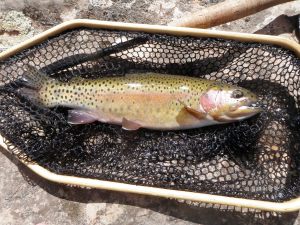Time: 10:00AM – 4:00PM
Location: Across from spring then island area below mile marker 12
Fish Landed: 18
Frying Pan River 09/05/2010 Photo Album
On Sunday morning Jane and I packed up the tent and all our camping gear early. Jane wanted to get back to Denver early, so we drove to the spring along the Frying Pan together where Jane filled her water bottle and departed for home. I planned to fish the Frying Pan on Sunday and return later, so I parked at the spring and prepared to fish across from the spring in the morning. I tied on a parahopper and beadhead hares ear then RS2 and waded below the line of trees between the road and river. I fished the pocket water then worked my way across and covered some attractive runs along the south bank. I couldn’t entice any action over the following 1.5 hours, so I waded back to the road and drove back toward the dam at around 11:30.
The upper Frying Pan appeared to be quite crowded on Sunday, with fishermen occupying all the nice locations. I hoped to fish the long run at the western boundary of the public water, but several fishermen occupied this desirable location. In addition a family with a guide was entrenched above the long run in the pool area next to the pullout. I decided to eat my lunch and observe the river for openings. While sitting on the bank, I could see the family and guide below me. I also spotted a medium size brown in a narrow slot between some heavy current and the bank right in front of me.
When I resumed fishing, I floated my three fly combination through the slot where I ate lunch and momentarily hooked the brown I’d observed. I concluded I could work my way upstream from that point and fish the obscure slots and pockets at the bottom of the island and then head up the right channel and see if any fishermen occupied the sweet pool below the large cube rock at the head. I landed four small brown trout in the pocket water below the island and then on the lower end of the right channel around the island. I was amazed to discover no fishermen in the nice run and pool below the large rock, so I positioned myself at the tail. I expected another fisherman or two to come crashing through the willows at any time, but it never happened.
Initially I spotted some fish toward the tail of the pool and attempted to entice them with the hopper/dropper then switched through a number of flies. But it didn’t take long before some hatching action commenced at around 1:15 or 1:30. There were some clouds in the sky, but it was mostly sunny with gusty winds coming into play occasionally. I was anxious to try the new flies I’d purchased, so I prospected with both before any real hatch activity got underway. I received a couple refusals, but concluded the fish weren’t interested since they hadn’t seen enough naturals yet. When the green drake imitations didn’t work, I switched to the red-olive comparadun that I use to imitate the red quills. I was assuming that these mayflies would appear first. I managed to land a small brown on this fly along the left side of the pool, but the red quills never materialized as they did on Thursday closer to the dam.
In early May I experienced two fantastic days of fishing on the Arkansas River when I encountered the fabled caddis hatch. The next couple hours on the Frying Pan represented a third highlight of the 2010 season. The green drakes began to emerge in earnest at around 1:30. I spotted two rises next to a medium size rock along the left bank. I tossed the purchased flies in this area, but received no attention. What should I do now? The new killer flies weren’t working. I reverted back to the comparaduns that disappointed me on Thursday. I tied on the comparadun with the dark olive sparkle yarn body and fluttered it down to the place where the fish had risen. It worked. I hooked and landed a medium size brown. Next I spotted a single rise in the nervous water at the tail of the riffle where it entered the pool. I popped the comparadun into the riffles and as it floated through the sweet spot it was engulfed by a large mouth. I played the brown and eventually landed it. This brown had a huge hook jaw and measured the length of my net opening, but the hook was embedded awkwardly in the hooked jaw, and when I used my hemostats to remove, broke the point off.
For some inexplicable reason, I replaced the olive sparkle yarn comparadun that had just caught two nice fish with a different comparadun. This fly had an exaggerated tall deer hair wing and an abdomen constructed with an olive dubbing and maroon thread ribbing. As it worked out, this proved to be a stroke of genius. I moved up above the pool to the top of the island. There were at least ten juicy deep pockets in this area and I fully expected to bump into other fishermen, but it never happened. The next hour in this area was magical. I cast the comparadun to the pockets and held my rod high so the line didn’t touch the water and introduce drag. In nearly every pocket, one or two fish would magically appear and inhale the green drake that was easily visible with the high wing. It is hard to describe the feeling of confidence one gets when there is a good hatch, and the fisherman has found the imitation that the fish take with confidence. I landed eight trout in this manner, half browns and half rainbows, and the fish were averaging 13 inches in length but well fed and chunky.
Once I’d exhausted all the nice pockets and tasty water at the top of the island I circled back down the road to the car and added a few more of the maroon ribbed comparaduns to my patch. Next I noticed no fishermen in the smaller left channel between the island and the road, so I decided to give that area a test.
I dropped down the bank to the bottom of the left braid. This water was smoother and slower than the water above, and the green drake wasn’t producing so I switched to a light gray comparadun. My theory was that the pale morning duns generally prevail in late to mid-afternoon after the intense green drake hatch. This proved to be a valid theory, and I landed an additional four trout as I worked my way up the left channel to the top of the island again. The last two were very nice chunky fish, one a brown and one a rainbow that sipped in the light gray dun with confidence in the last two small pools at the top of the channel. I had spotted the rainbow from the top of the island and made several efforts to entice it with casts from above. In this case the upstream presentation worked.
When I reached the top of the island I fished my way up through the fast channel with the light gray dun. I covered the slack water along the edge, but didn’t have any luck. I skirted the bend pool at mile marker 12 and dropped back down to the river above the large flat rock where I’d caught some nice fish last summer. The rock creates a long eddy where you actually have to get on the rock and cast downstream so the eddy brings the fly back toward the rock. I spotted a couple decent fish rising as I walked by on the road, but once I got in position lying on the flat rock, I couldn’t bring any of the fish to the top for my fly. It was now 4PM so I decided to call the day a success and begin the four hour drive back to Denver.





